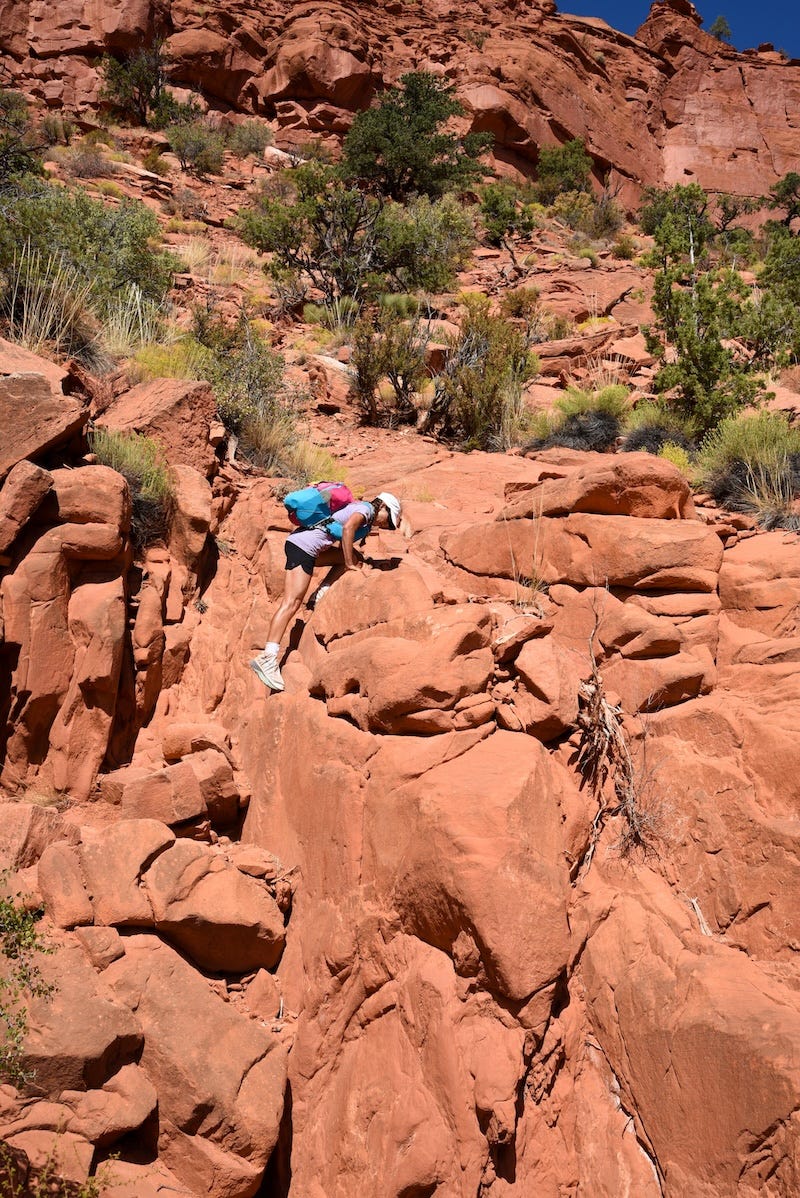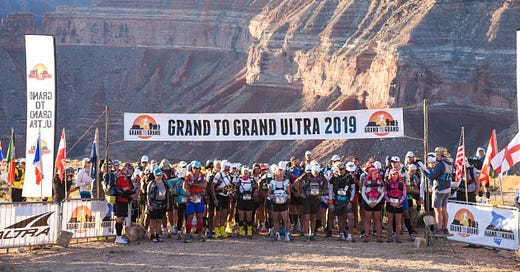I Fell Behind In Prep For a Big Race, Now What?
Plus, my campaign to help protect and expand public lands

Playing catch-up and racing time
Less than two months remain between now and September 22, when I’ll stand on the north rim of the Grand Canyon and start a weeklong 170-mile self-supported, off-the-grid stage race called the Grand to Grand Ultra with competitors from around the world. I’ll carry all my food and gear for the week on my back and camp each night.
Two months! That realization cut through my Covid brain fog and low-grade fever last Saturday when I looked at the calendar and thought, “Wait, I need to travel to Kanab, Utah, two months from today?! How can that be? I thought I had almost three months left!”
Panic momentarily gripped me as I realized I’m way behind in preparation for my year’s main goal. I experienced the feeling that we runners have in nightmares that involve being late and unprepared for a race. (I’ve had many crazy, haunting starting-line dreams in which I’ve lost my drop bags or discovered that they’re full of junk, or I can’t make my phone’s map work to find my way to the race, or I can’t make my fingers work to pin on my bib, and my bib is so big that it covers my entire shirt and I fumble to fold it into a smaller size—and then my kids appear in my dream needing something, like feeding or bandaging, adding a layer of maternal angst!)
The past four weeks sped by and knocked me on my ass. Both my run training and my writing routine suffered as I traveled for a wedding, then focused on a couple of timely projects, then went to Silverton for five days of Hardrock involvement, then came down with a strong case of Covid.
I have done the Grand to Grand Ultra three times (2012, ‘14, ‘19) plus its one-time sister race, the Mauna to Mauna on Hawaii (2017). Each of those times, I was much more trained and fit by mid-July. Now, with only about five weeks left for quality training before needing to taper, I need to cram in pack training, heat training, and normalize back-to-back long runs.
It didn’t help that last Saturday, while managing anxiety about being behind in everything, I wasted too much time obsessively tracking friends who were running the High Lonesome 100, Ouray 100, Tahoe Rim Trail 100, and Vermont 100 races. It seemed as if most ultrarunners I know were in peak shape performing outstanding efforts, and meanwhile I was at home getting dizzy and feeling sore from a simple downward dog.
Reluctantly, but wisely I know, I pulled out of the Never Summer 100K I was signed up to run this weekend. I had viewed it as a key long training run that would simulate the time on feet and energy needed for the Grand to Grand’s extra-tough 53-mile long stage. But I realized it would be a recipe for failure to line up for it undertrained, weak, and it might trigger a rebound case of Covid and the need for extra recovery.
So now I feel like I’m starting from scratch, given the post-Covid weakness and low training volume. Objectively I know that’s not true; I ran two hearty ultras in spring and early summer and trained pretty well leading up to them. But I can’t deny I’m not where I planned to be, and I don’t have time left to train as much or as fully as I’d like.
I’ve faced this situation of being undertrained and unprepared before. Most athletes do at some point, too. What should we do in this situation?
One option is to pull out of the competition, just as I pulled out of this weekend’s 100K. But in the case of the Grand to Grand, given my feelings toward it, no way! This event is so special and means so much to me that I’ll be there even if I wind up hiking so slowly that I chase cutoffs. I’d rather be there, perform poorly, and suffer than miss it altogether.

So here’s what I’m going to do, which might help you, too, if you face a competition or a big goal with only a fraction of the time and prep you had hoped you’d have:
Do what you can. A lot of preparation for an ultra or any big athletic goal involves logistical prep—like gear and travel planning—and mental prep. Work on that when you can’t train. For the self-supported Grand to Grand, logistical planning for gear and food matter arguably as much as physical prep; you won’t get very far across the desert if your backpack malfunctions or you brought the wrong things to eat. Therefore, last week while sick, I at least accomplished some preparation by creating a spreadsheet of food choices for the week and making a gear inventory.
Lower expectations. This may be your “A” race, but you may not be able to bring your “A” game, and that’s OK if you have other compelling reasons to do it. Ask yourself, what’s realistic? What’s your baseline goal rather than your aspirational goal? For the Grand to Grand, my base goal is to survive and finish while soaking up the experience of this immersive wilderness experience. I’ve been working on accepting the fact I will be a mid-packer, perhaps even a back-of-the-packer, given how my body changed in the past five years plus my current under-training. In the four prior editions of this race format, I earned a podium spot (second or third place) three times and won it in 2019. That’s not likely this time—and, it’s less important to me. (I had to remind myself of this last Saturday when I saw the likely top female competitor at this year’s Grand to Grand, Sarah Ostaszewski, finish High Lonesome 100 in third place with a phenomenal time, hours faster than when I ran HiLo100, and I thought, “I’m so completely outside of her league, and I’ll be hours behind her at the Grand to Grand!”)
Stoke your desire and “why.” Asking the rhetorical questions “why bother?” and “why suffer?” can force you to articulate whether and why you want to do this hard thing. Personally, I have many reasons for wanting to do the Grand to Grand one more time, including to revisit the remote, wild route and unplug for a week, and to test my endurance as I move through the hot, sandy landscape. When I think about the daily routine of racing in the desert, then recovering at camp, I get a thrill of excitement to live for a week in that setting again.
Keep a sense of humor and adventure. As Yvon Chouinard once said (to paraphrase), adventure starts when things go wrong. When I tell stories about my past Grand to Grand experiences, they tend to be about mishaps. To give one small example, from Stage Five in 2014, I was feeling extra calorie-deprived and started to devour my precious nightly dehydrated meal-in-a-bag of over-salted pasta. Suddenly, I bit into something so hard that it could’ve chipped a tooth. With dread and disgust, I pulled a piece of metal hardware from my mouth that looked like a thick washer for a bolt. Realizing that this remnant of industrial waste had made it into my prepackaged meal (could there be more?), I could’ve refused to eat the rest, but I was too hungry. So I shrugged, tossed the round piece of metal over my shoulder, and said, “extra crunchy, metallic aftertaste, two stars.” That was one instance of many where I consciously chose to laugh instead of get upset. Things will go wrong or surprising in ways that may contribute to a sub-optimal performance, and we can’t control those circumstances, but we can choose and control our responses to those mishaps.
Believe in the magic of race day (or in the case of the Grand to Grand, race week). I know from experience that we can do more during an event that we care about, with the event’s support and camaraderie to boost us, than we can in any regular training run. You can always do more than you think you can.
The landscape that needs protecting

The Grand to Grand Ultra’s route starts at the north rim of the Grand Canyon in Northern Arizona, skirts the town of Kanab, and ends close to Bryce National Park in Southern Utah on an overlook of the Grand Staircase—the massive multi-hued geologic formation made of cliffs and slopes that give the appearance of giant steps like stairs. It’s a stunning and varied landscape with numerous ecological zones, from high desert to riparian and forest. We’ll experience a wide temperature range from very hot during daytime stages to near freezing at a couple of the event’s high-altitude camps.
The route runs through or near numerous environmentally sensitive areas—some that are protected as National Monuments, National Conservation Areas, and Wilderness Areas, and others that are designated “areas of critical environmental concern” that hopefully are on a path to be safeguarded. Most of these lands are managed by the Bureau of Land Management (while some segments of the Grand to Grand’s route cover US Forest Service, state park, or private land).
If you’ve followed this newsletter, you know I occasionally write about the Bureau of Land Management and the nonprofit I strongly support, the Conservation Lands Foundation, which advocates for protecting and expanding certain areas of BLM-managed public land that are extra sensitive or threatened environmentally, and/or that have indigenous cultural and archeological significance.
I try not to get overly political here, but we shouldn’t ignore what’s at stake for the environment in general and public lands in particular with this presidential election. As described in this article, the conservative agenda seeks to dismantle decades of progress on the environmental front, and scale back or eliminate the protected status of National Conservation Lands managed by the BLM.
With the clock racing to slow climate change and conserve the West’s shrinking wilderness and biodiversity, I feel compelled to do what I can. That’s why I’m launching a fundraiser for the Conservation Lands Foundation in conjunction with my participation in the Grand to Grand Ultra.
I have so much to say about this cause and the context. But rather than summarize it here, I will use the coming weeks’ posts to share more pieces of information. For now, please visit my fundraiser page to read the basic info and if you have time, I hope you’ll watch this short video about the Conservation Lands Foundation.
Thank you for reading! Often I end this weekly newsletter with a pitch to become a paid subscriber, or I link to my “virtual tip jar.” For the next eight weeks, I’ll only ask for your support of my fundraiser for this nonprofit.



Sorry to miss seeing you at never summer, but probably a smart choice. We met at whiskey basin awhile back.
Sounds like a wonderful event-nights in the desert, perhaps my favorite time/place to be. Please don't tax your body too much as you recover. Best, Polly